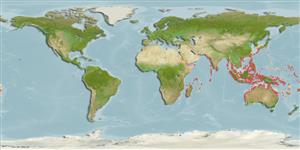>
Mugiliformes (Mullets) >
Mugilidae (Mullets)
Etymology: Crenimugil: Latin, crenulatus = cut, clipped + Latin, mugil = grey mullet (Ref. 45335).
More on author: Bleeker.
Issue
Considered here as provisionnally accepted species. Considered as a junior synonym of Crenimugil pedaraki in Senou, 2002 (Ref. 123264). Genetic data supports the population from the Indian Ocean to be restricted to Crenimugil buchanani; the Philippine population is probably an undescribed new species (J.T. Williams, pers. comm. 12/2018). More studies are needed, or send references.
Environment: milieu / climate zone / depth range / distribution range
Ökologie
seewasser; süßwasser; brackwasser; katadrom (Ref. 46888); tiefenbereich 0 - 10 m (Ref. 86942). Tropical; 39°N - 37°S, 22°E - 178°W
Indo-Pacific: from South Africa through parts of Indonesia to parts of Micronesia and Melanesia; north to the Mariana Islands and southern Japan (Ref. 9812).
Length at first maturity / Size / Gewicht / Alter
Maturity: Lm 36.0 range ? - ? cm
Max length : 100.0 cm TL Männchen/unbestimmt; (Ref. 4393); common length : 35.0 cm SL Männchen/unbestimmt; (Ref. 4967)
Rückenflossenstacheln (insgesamt) : 5; Rückenflossenweichstrahlen (insgesamt) : 8; Afterflossenstacheln: 3; Afterflossenweichstrahlen: 9.
Found in coastal waters, including estuaries and rivers (Ref. 5213). Young fish frequent estuaries and also ascend rivers and coastal creeks (Ref. 2847). It feeds on algae, diatoms, detritus, and crustaceans (Ref. 9812). Oviparous, eggs are pelagic and non-adhesive (Ref. 205). Caught during the spawning period (Ref. 9812). Other methods include the use of stakenets, pouch nets, and barrier nets (Ref. 9812).
Life cycle and mating behavior
Maturities | Fortpflanzung | Spawnings | Egg(s) | Fecundities | Larven
Harrison, I.J. and H. Senou, 1997. Order Mugiliformes. Mugilidae. Mullets. p. 2069-2108. In K.E. Carpenter and V.H. Niem (eds.) FAO species identification guide for fishery purposes. The living marine resources of the Western Central Pacific. Volume 4. Bony fishes part 2 (Mugilidae to Carangidae). FAO, Rome. (Ref. 9812)
IUCN Rote Liste Status (Ref. 130435)
Bedrohung für Menschen
Harmless
Nutzung durch Menschen
Fischereien: kommerziell
Tools
Zusatzinformationen
Download XML
Internet Quellen
Estimates based on models
Preferred temperature (Ref.
123201): 24.1 - 29, mean 28 °C (based on 1174 cells).
Phylogenetic diversity index (Ref.
82804): PD
50 = 0.5625 [Uniqueness, from 0.5 = low to 2.0 = high].
Bayesian length-weight: a=0.01349 (0.00893 - 0.02037), b=2.99 (2.87 - 3.11), in cm total length, based on LWR estimates for this species & (Sub)family-body (Ref.
93245).
Trophic level (Ref.
69278): 2.2 ±0.11 se; based on food items.
Widerstandsfähigkeit (Ref.
120179): niedrig, Verdopplung der Population dauert 4,5 - 14 Jahre. (Preliminary K or Fecundity.).
Fishing Vulnerability (Ref.
59153): High vulnerability (60 of 100).
